Russian Civil War
 From Rationalwiki
From Rationalwiki 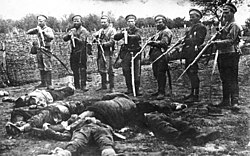
“”In war, where both success and failure are repaid by death, hostile agents who penetrate into the rear are subject to execution. This is inhuman, but no one ever considered war a school of humanity.
|
| —Leon Trotsky, Terrorism and Communism (1920).[1] |
| It never changes War |
| A view to kill |
v - t - e
|
The Russian Civil War was a multi-faction clusterfuck which tore Russia apart between the years 1917 and 1923. It was the consequence of political upheaval in the era of World War I (WWI), which first caused the February Revolution, which overthrew the Tsar of Russia in March 1917, and then led to the October Revolution of the same year. The Red Guards, inspired by the Bolshevik faction led by Vladimir Lenin, seized control of Petrograd (present-day Saint Petersburg) during the October Revolution and cast out the old Russian Provisional Government in the name of communism. Opposing the Reds, the loosely-allied White Movement included just about every other political interest in Russia, the monarchists and capitalists and (some) social democrats, all of whom fought against the rise of Bolshevik rule. Also involved were anarchists, peasant revolts, stray Czechs, and separatists from various fringe regions in the old Russian Empire, especially the Turkic peoples of Central Asia, the Baltic states, and Ukraine. Many of the various Entente nations of WWI, including the United States, France, the United Kingdom and Japan, intervened in support of the White armies. Some of the Central Powers including the German Empire and the Austro-Hungarian Empire, also intervened to keep the territorial gains which Lenin had promised them in the 1918 Treaty of Brest-Litovsk.
So yes, the war was a total shitstorm. The October Revolution had caused the collapse of the Russian Provisional Government (in power from March to November 1917), meaning that warlords and separatists had the chance to rise up with little initial resistance. While the Bolsheviks dominated much of European Russia due to their popularity with rural peasants and city laborers, the Whites established a rump state further east in Siberia. The Whites were immediately weakened by infighting, though, as a coup brought Russian admiral Alexander Kolchak to power in Siberia and turned the rump Russia into a military dictatorship. Kolchak's military offensives proved ineffective due to the unfavorable terrain of eastern Russia as well as the general lack of public support for the Whites, while the Red Army conscripted huge numbers of soldiers and controlled Russia's industry. When the White cause became a lost cause, the Entente powers withdrew and left the Whites basically defeated by late 1919. The Whites retreated frantically further east and south; their hopeless resistance persisted until 1923.
The Bolsheviks also suppressed or co-opted many of the independence movements which had caused problems for various factions in the early phases of the war. However, Finland, Estonia, Latvia, Lithuania, and Poland succeeded in fending off Soviet forces and at least temporarily establishing themselves as independent countries. For all but Finland, this state of affairs ended with World War II (1939-1945) when the Soviets annexed the Baltic nations (1940) and turned Poland into an oppressed Warsaw Pact puppet state (1944 onwards).
The human cost of the war was horrific, with somewhere between 7 and 10 million people dying in battle or in harsh conditions or from starvation or from the many many massacres and atrocities carried out by both sides.[2] The political consequences were also disastrous. The hopeful peasant and workers movement that had risen up in mass participatory Soviet assemblies was destroyed by the war, and the only real power left in Russia was Lenin's Communist Party.[3] With Russia's economy in ruins and its people terrorized and suppressed, civil war had set the stage for the horrors that would befall the nascent Soviet Union.
Opening hostilities[edit]
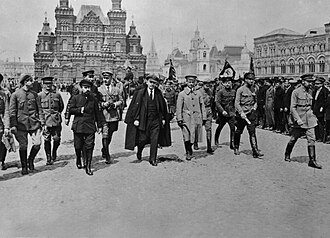
Aftermath of the Bolshevik coup[edit]
It is November 1917. The Bolsheviks have successfully taken control of Russia's capital Petrograd during the October Revolution, which was really a popular coup led by the Petrograd Soviet and its Red Guards.
Unfortunately for the Bolsheviks, the rest of Russia wasn't nearly as keen on accepting their rule, and the Russian military largely disintegrated upon receiving the news that the communists had taken charge.[4] That left Lenin and Trotsky with a few immediate problems: (1) how to protect Petrograd, (2) how to build a military from scratch, (3) how to get the Central Powers off their asses, and (4) how to transform a worker and peasant movement into a force capable of taking on most of Russia's military establishment and wealth. Things seemed pretty grim for them at the start of the war, but the conflict's progress would reveal some important advantages for the Reds that weren't immediately obvious.
The most pressing problem actually ended up being the Germans. The Provisional Government's attempt to retake Petrograd was hasty and poorly planned, and the zealous Red Guards had relatively little problem fighting off Alexander Kerensky's forces.[5] The Germans, on the other hand, launched Operation Faustschlag in early 1918, fighting across the Baltic regions and directly threatening Petrograd itself.[6] Moscow, also a large industrial city, was relatively easy to take under Soviet control as well, and it was also much more secure from the German advance. Thus, Lenin made the decision to hastily relocate Russia's government institutions to the city of Moscow, finalizing the arrangement on 12 March, 1918.[7]
The Red Army and the Cheka[edit]
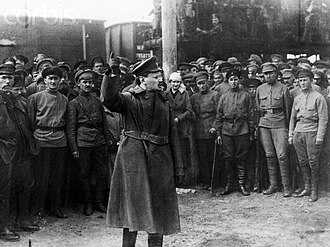
Guy behind him is thinking "Is that toilet paper stuck to his boot?"
The Bolsheviks were fortunate in that they did have all the ingredients for building a military. First, the Red Guards already existed, and they counted a membership of around 200,000 people across Red-controlled areas.[8] They were untrained, however, and 200k wasn't nearly enough to win a land war in Asia. Leon Trotsky took control of the effort to build a Red Army, and he immediately realized that the Red Army needed a core of professional officers if it was to survive against the various White forces. In a controversial move, Trotsky forcibly conscripted Tsarist officers into the Red Army, arguing correctly that the old Russian Imperial Army was the only source of professional soldiers to which the Reds had access.[8] Of course, Trotsky didn't quite trust those men who had fought for the old order, so he also had political commissars attached to every Red Army unit so that they could report to the Party on those officers' performance and loyalty.[8]
Loyalty from officers and the people was also enforced by the terrifying All-Russian Extraordinary Commission. Commonly known as the "Cheka", this was a secret police organization ordered by Lenin and vested with the power to act completely outside the constraints of both law and morality in their mission to root out counter-revolutionary sentiment.[9] Its first leader was "Iron" Felix Dzerzhinsky, a communist fanatic who ordered numerous massacres[10] and often spent his entire waking day hunting enemies of the revolution.[11] It's been said that Dzerzhinsky, a Pole, is revered by other Poles for having killed more Russians than any other among them.
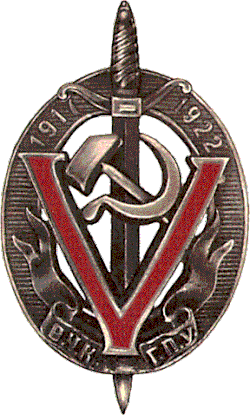
Still, defections and desertion from the Red Army remained a significant problem throughout the war. Trotsky realized this, and it apparently pissed him off quite a lot. In September 1918, Trotsky issued Special Order 30, stating,[12]
“”Cases of treacherous flight by members of the commanding apparatus into the enemy’s camp, though less frequent, are still occurring. These monstrous crimes must be stopped, without shrinking from any measures. The turncoats are betraying the Russian workers and peasants… Let the turncoats realize that they are at the same time betraying their own families: their fathers, mothers, sisters, brothers, wives and children. I order the headquarters of all the armies and also the district commissars, to supply by telegram to Revolutionary War Council member Aralov, lists of all the members of the commanding apparatus who have gone over to the enemy camp, with all needful data about their family situation. I entrust Comrade Aralov with the responsibility for taking, in cooperation with the appropriate institutions, the measures necessary for arresting the families of deserters and traitors…
|
Yikes. Meanwhile, Trotsky also set about making up the Red Army's manpower shortage. He did this by implementing mandatory conscription for peasants in Red-controlled regions.[13] If village people opposed or tried to avoid the draft, the Reds would take hostages and threaten to shoot them if noncompliance continued.[14] Noncompliance usually didn't continue.
Brest-Litovsk Treaty[edit]
.jpg)
Negotiations to end the war with the German Empire began as early as December 1917, but the Germans were frustrated by the Bolshevik reluctance to make the concessions that Germany wanted. Operation Faustschlag, in which the Germans started kicking the Russians all the way to Petrograd in early 1918, did quite a bit to convince the Bolsheviks to become more cooperative.[15]
The leading Reds were split on what to do at this point. Trotsky wanted to unilaterally stop fighting against the Germans without a treaty, Lenin wanted to sign a bad treaty rather than potentially be forced to sign an even worse treaty after more fighting, and the left communists like Nikolai Bukharin wanted to wait for an "inevitable" communist uprising in the Central Powers and then fight back with revolutionary allies rather than capitulate to imperialism.[16] Lenin ultimately forced the matter by threatening to abruptly resign as head of the Central Committee, and the Committee voted to go along with Lenin's position rather than face a political crisis without him.[17]
The Treaty of Brest-Litovsk stung. Like, really really badly. Russia gave up close to half its European territory, ceding Russian Poland, Lithuania, and part of Latvia to be annexed by Germany and Austria, while also allowing Ukraine, Finland, Estonia and the rest of Latvia to become Central Powers puppet states.[18] Oh, and that was on top of steep reparations payments. Those lost regions, especially Ukraine, had Russia's best agricultural land, 80% of its coal mines, and half of Russia's industry.[18] Goddamn. Russia got grabbed by the Brest. The treaty was so humiliating that Trotsky actually refused to sign it and made his aide do it instead.[18] It's funny that the Germans got so butthurt over the Treaty of Versailles when they had so recently forced a much worse treaty on poor old Russia.
Many Russians considered the treaty to be a hideous betrayal of their country, and popular anger over the matter played a considerable role in getting support to escalate matters into a total civil war. The Entente Powers also felt betrayed, and they began contemplating an intervention to overthrow the Reds.[19] The Central Powers immediately started moving into the ceded territories in order to consolidate their hold.
The Treaty also caused problems for Lenin in his own house, as part of his own political coalition splintered against him over the treaty during the Left Socialist Revolutionary uprising.[20]
White movement forms[edit]

Disorganized resistance against the Bolsheviks began from a number of factions in a variety of different regions as anti-communists rose up across Russia. The movement was strengthened significantly after the Bolsheviks shut down the aborted attempt at an elected legislature and then signed away huge chunks of Russian land in the Treaty of Brest-Litovsk.[21] The first militarily significant uprising came from the Czechoslovak Legion, a volunteer force assembled from exiles from the Austrian Empire, and who revolted after learning that Russia would no longer fight against Austria.[22]
Even after they started banding together, White forces were very disorganized. They tended to be armies that acted independently, usually under the command of former Tsarist generals.[23] The term "White", with its implication that the movement was monarchist, was actually a misnomer since huge numbers of republicans, liberals, democrats and non-Bolshevik socialists also fought within the movement.[23] Notable commanding generals included the hated General Lavr Kornilov (see October Revolution), General Anton Denikin who failed to take Moscow, General Pyotr Wrangel who was probably the most competent leader, and Admiral Alexander Kolchak.
Like the Reds, the Whites needed manpower to win the war. Also like the Reds, they resorted to extortion and terror to forcibly conscript peasants into their armies.[24] A significant advantage the Whites had was foreign aid, as many Western nations supplied them with arms and cash to fuel the war against the Bolsheviks. Winston Churchill supported aid to the Whites, although he very much opposed sending troops, saying, "The aid which we can give to those Russian armies which are now engaged in fighting against the foul baboonery of Bolshevism can be given by arms, munitions, equipment, and by the technical services."[25]
Entente intervention[edit]

While Churchill was openly supportive of an ideological crusade against the Reds, leaders like British PM David Lloyd George and American president Woodrow Wilson were a lot more reluctant to get involved in what was sure to be a catastrophic bloodbath in Russia.[26] While political pressures forced an intervention, the general top-level reluctance ensured that it wasn't to be a significantly proactive one.
Instead of directly fighting alongside the Whites, most Entente forces stationed themselves in or around important regions in Russia, like the port cities of Murmansk and Archangel in the north or the Trans-Siberian Railway.[26] Economic and military aid also slowed down considerably since WWI was still ongoing and the Entente powers wanted to shift focus on rebuilding their own countries as soon as possible. Despite the clearly unenthusiastic nature of the "intervention", Red propaganda didn't hesitate to use it as proof of an "international capitalist conspiracy" against Russia.
The Reds were also quite keen to force the Entente occupiers out of Russia. About 5,000 Americans were deployed in the north of Russia, and 8,000 were sent to Vladivostok to help keep the Trans-Siberian railroad running. Defensive fighting cost them dozens of men even after Armistice Day.[27] Other participants like France and the United Kingdom also suffered significant losses and found themselves struggling against the fact that the White forces often hated each other even more than they hated the Reds.[28]
But the largest force by far came from Japan, which deployed some 70,000 troops with the goal of seizing resource-rich land in Siberia and with no interest in who won the war in Russia.[28]
Other anti-Bolshevik uprisings[edit]
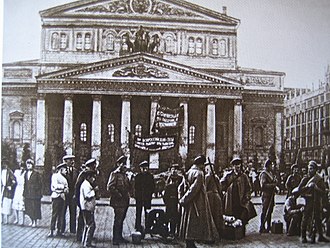
Left SR uprising[edit]
“”The Left Socialist Revolutionaries suddenly discovered that they were cooperating with a regime of prudent politicians who make deals with Germany… and again called on the 'bourgeoisie' to manage factories and command the army. What happened to the revolution? In the spring of 1918, the Left SRs began to treat the Bolsheviks in the same way that the Bolsheviks themselves treated the Provisional Government and democratic socialists in 1917.
|
| —Richard Pipes, Russian historian at Harvard.[20] |
.jpg)
The Left Socialist Revolutionaries (Left SRs) were originally allied with the Bolsheviks and had voted in support of the Bolshevik takeover of the Provisional Government.[29] Lenin rewarded them for their loyalty by allowing Left SR members into the new Russian government, even into military and Cheka positions. However, their rise to power soon exposed the surprisingly deep political disputes which existed between them.
The Left SR faction's effective leader was Maria Spiridonova, who had become famous in 1906 for personally murdering a brutal Tsarist police officer and then enduring torture and rape while in prison.[30] Her instincts tended to be more popular-based and democratic than Lenin's and she was soon alienated by the increasingly brutal and extralegal powers wielded by Lenin's Cheka forces.[31] The Left SRs also opposed Lenin's reliance on the death penalty.
The Left-Bolshevik alliance ended abruptly after Lenin made the choice to accept the Treaty of Brest-Litovsk. Spiridonova was personally enraged over the treaty's capitulation to the Germans, and she personally ordered the assassination of the German ambassador in Moscow, Count Wilhelm von Mirbach.[30] Left SR members also withdrew from the government after seeing the German Empire start to move into Ukraine and violently put down peasant opposition.
This finally culminated in an outright revolt of Left SR forces in Moscow in summer 1918, where they tended to hold the upper hand. They seized control of most of the city, detained Cheka head Felix Dzerzhinsky, and put the Kremlin under siege.[31] Unfortunately, that was about where it ended. The Left SRs had never planned to assume power, and they weren't prepared to actually take the final step and seize the Kremlin and the government. Within a few days, the Red Army stormed Moscow, hunted down the Left SR members, and then had the party declared illegal. Maria Spiridonova was subjected to repeated arrests and brutal prison abuse for the crime of speaking out against Lenin's government, and she was eventually assassinated on the orders of Joseph Stalin in 1941.[30]
Lenin never forgot the uprising of his former allies, and Stalin later used it as part of his motivation for purging the Soviet government.[32]
Basmachi war[edit]

In Central Asian regions of the Russian Empire, now countries like Kazakhstan, Turkmenistan, and Uzbekistan, the long-oppressed majority Muslim populations rose up against the Russian Tsarist regime during WWI to fight against being conscripted to die on the fronts.[33] This uprising was called the Basmachi movement, and it didn't stop after the fall of the Tsarist regime. Instead, many of the Basmachi participants established their own states in the hopes of fighting for independence.
The Reds were weak in Central Asia, with most of their strength being concentrated in the relatively small Tashkent Soviet. The Tashkent Soviet was also unpopular with the locals of Central Asia since its decision-making committee had only two Central Asians on it.[34] Because of the Red weakness in the region, they weren't able to prevent Muslim elites from establishing their quasi-independent states, although many of those states were under partial or total occupation by White forces.[35] The Reds were keen to establish their rule in Central Asia, however, and by any means necessary. One of the first actions they took in the war against the Turkic peoples was a horrendous massacre in Kokand of around 25,000 people.[36] The massacre naturally had the opposite of the intended effect, instead rallying many more Central Asians to the movement. The Tashkent Soviet was totally unable to prevent guerrilla actions across the countryside, and the White movement usually allowed the Basmachi guerrillas to attack the Reds.
Baltic independence wars[edit]
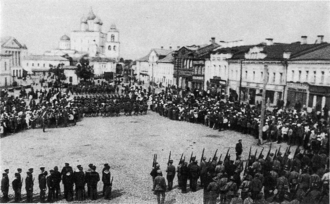
European countries also fought against the Russians to gain independence from the Russian Empire. Lithuania quickly threw off German rule thanks to Germany's revolution and defeat in WWI and then turned its attention against the Russians. The Red Army advanced relatively easily through Lithuania, but a hastily assembled force of Lithuanian and German volunteers halted the Red Army at the gates of Lithuania's capital Kaunas in late 1918.[37] The Reds soon had bigger problems to deal with (meaning Poland and the Whites), so they gave up on Lithuania for the time being and recognized its independence in 1920.
Estonia also fought for its sovereignty, this time against leftover German forces, the Whites, and the Reds. Estonia was in a particularly bad situation, as its population had little faith in the republic's independence and its towns were on the brink of starvation.[38] However, Estonia was saved by the timely arrival of supplies and weapons from the Royal Navy plus volunteers and more weapons from Finland.[38] Meanwhile, Estonia used the time that bought to hastily build a fighting force. Since the Reds were fighting along a very broad front, the Estonians were able to concentrate their forces and push the Reds back, eventually taking the Russian city of Pskov.[39] Thus, Estonia was also able to preserve its independence after Soviet concessions. Latvia also gained its independence by allying with Estonia and receiving foreign aid.[40]
Ukrainian independence wars[edit]
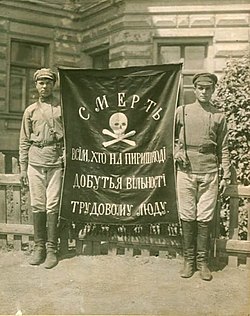
“”I am asked: 'You consider yourselves socialist-Communists, and yet you are shooting and imprisoning your Communist Anarchist comrades.' This, comrades, is indeed something that deserves explanation. We Marxist Communists are profoundly opposed to the Anarchist doctrine. This doctrine is erroneous… [V]ery many hooligan-type carrion-crows, robbers and night-prowlers of all sorts have gathered under the flag of Anarchism… If the sham Anarchists, who are really thugs, try to go on acting along the same lines as before, then the second showdown will be three times, ten times, harsher than the first.
|
| —Leon Trotsky, How the Revolution Armed.[41] |
Unlike the Baltic states, Ukraine wasn't able to fully rally around a single government. In Kiev, the Ukrainian National Republic was destroyed by coups launched by various generals, and the remnants of that regime had to contest various regional governments.[42] Ukraine also had to fight against Poland over the two countries' competing territorial claims.[43]
In eastern Ukraine, anarchists led by Nestor Makhno attempted to form a stateless society based upon "free soviets" and "communes".[44] Makhno's Revolutionary Insurrectionary Army of Ukraine became known as the Black Army for their distinctive flag calling for death to oppressors. Inside the Free Territory, roughly 7 million lived in cooperatives and owned industry and land collectively.[45] This experiment was not to last. The Free Territory came under assault by the Reds, who viewed them as an obstacle to the reunification of Russia. The Red Army was vastly larger and had better equipment, and they used terror and massacres to destroy peasant regions loyal to the Free Territory.[46]
The other Ukrainian governments were also crushed beneath the great power of the Red Army.
Escalating brutality[edit]

Red Terror[edit]
“”Dombrovsky, a teacher, whose only fault was that during a search they found a suitcase with officer clothes left behind by a family member passing through the town, was tortured in a solitary cell… Firstly she was raped and abused. Then she was tortured in order to extract information of where she was hiding gold. First, they carved her naked body with knives, then crushed the fingertips with pliers.
|
| —Sergei Melgunov, accounts of Cheka torture, 1924.[47] |

In August 1918, liberal socialist Fanya Kaplan shot Lenin in retaliation for his closing of the elected Constituent Assembly; the bullet unfortunately failed to kill him and Kaplan was executed.[48] It's also notable that Kaplan's near-delirious mental state after being subjected to torture casts extreme doubt on the validity of her confession.[49] Still, she was a useful scapegoat for a regime eager to start cracking down on its opponents.
This marked the point where the Bolsheviks started brutalizing everyone opposed to them. At the forefront of this wave of state-sanctioned political violence was the Cheka and its terrifying leader, Felix Dzerzhinsky. Cheka agents carried out some 8,500 summary executions in the first year of the Terror and ten times that number were arrested, interrogated, tortured, or sent to labor camps.[50] The Red Terror was also boosted by a vicious propaganda campaign from the Bolshevik government calling for revenge and hatred against their various enemies.[49] Lenin also personally ordered certain atrocities, such as in the infamous "hanging order" in which he demanded that 100 Ukrainian dissidents be hanged publicly and then their villages' food stores confiscated.[51] The first victims were Left SRs, but the purge soon expanded to former tsarists, liberals, Mensheviks, members of the Russian Orthodox church, foreigners, anyone who dared to sell food or goods for profit.
Lenin's Red Terror set the stage for the rest of Soviet history, creating a legal precedent that Joseph Stalin would use to justify the Great Purge and the murder of millions.[52]
Execution of the royal family[edit]
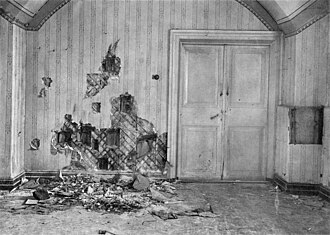
“”I saw that all the members of the Tsar's family were lying on the floor with many wounds in their bodies. The blood was running in streams. The doctor, the maid and two waiters had also been shot. When I entered the heir was still alive and moaned a little. Yurovsky went up and fired two or three more times at him. Then the heir was still.
|
| —Pavel Medvedev, former prison guard of the royal family.[53] |
After being deposed in the February Revolution, ex-Tsar Nicholas II was a political nonentity. He had returned to Petrograd after his abdication, and the revolutionaries almost immediately had him imprisoned along with his family. The Romanovs were eventually moved to Yekaterinburg due to fears that Petrograd was under military threat and there they remained for the rest of their lives.[53]
In the early morning 17 July 1918, though, Red forces in Yekaterinburg were themselves threatened by nearby conflict with the rebelling Czech Legion, and the Reds feared that the Czechs would set the Romanovs free.[53] At that point, the Reds in Yekaterinburg made the decision to wipe out the royal family in order to prevent any possibility of them becoming a political threat to the new regime.
Head guard Yakov Yurovsky was initially harsh but fair to the Romanovs, according to eyewitness accounts from the surviving cleaning women who served the Romanovs in their house arrest.[54] The cleaning ladies were apparently surprised at how human and seemingly normal the royal family were, and Tsar Nicholas II (again proving his idiocy) apparently seemed to like Yurovsky.[54]
On July 17, Yurovsky became the royal family's executioner, as he and several other guards shot and bayoneted all of the Romanovs to death. They then stripped the bodies of valuable jewelry, mutilated the corpses with sulfuric acid, and buried the bodies in the forest.[55] White forces later took Yekaterinburg and investigated the murders, but the Reds spent decades being deliberately evasive as to the royal family's fate.
White Terror[edit]
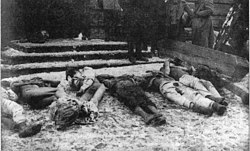
“”The truth about Kolchak (and his double, Denikin) has now been revealed in full. The shooting of tens of thousands of workers. The shooting even of Mensheviks and Socialist-Revolutionaries. The flogging of peasants of entire districts. The public flogging of women. The absolutely unbridled power of the officers, the sons of landowners. Endless looting.
|
| —Vladimir Lenin's hypocritical statement on the White Terror.[56] |
Like the White movement itself, the White Terror was largely decentralized and carried out by local warlords. Massacres and persecution tended to target socialists, communists, and especially Jews.[57] The worst instances of mass murder almost always happened after the Whites were forced to withdraw from a town or region.
General Kolchak was one of the most brutal figures of the entire war. His forces used mass floggings against underperforming soldiers, razed entire villages, burned farms, destroyed water stations, and tortured people in public as a means of terrorizing civilians.[58] Holy shit. White forces also frequently engaged in pogroms against Jews, because the prevailing logic at the time concerning massacring Jews was 'why not'?
Progress of the civil war[edit]
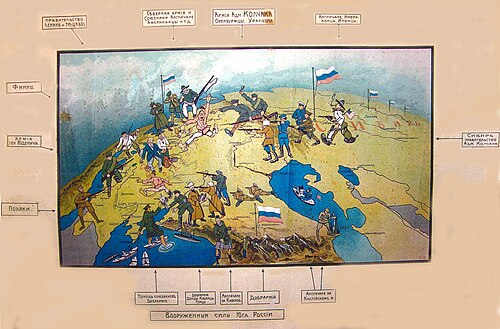
For our purposes, this poster shows the approximate locations of the three White armies.
Fighting in the south[edit]
Red forces were booted from Ukraine by the onslaught of the German and Austrian armies, and the subsequent collapse of the Central Powers allowed the independent factions in Ukraine to grow in the temporary absence of a greater power.[59] The White faction's Volunteer Army under command of Kornilov also had to retreat from southern Russia, coming under constant attack from Red forces and suffering the loss of Kornilov himself.[60] Despite these challenges, the Volunteer Army linked up with other White forces and Cossacks in the Caucasus.
Emboldened by their survival, the White forces in the Caucasus region launched the Kuban Offensive in June 1918, which resulted in their first significant victory over the Reds.[61]
Kolchak regime in Siberia[edit]
The White forces were broadly aligned under the Provisional All-Russian Government based out of the Siberian city of Omsk, but rivalries and political differences hampered its effectiveness and legitimacy.[62] With help from the Czech Legion's uprising and other regional warlords, the Whites were able to gain control of most of Siberia plus its vital railroad.
In November 1918, General Alexander Kolchak launched a coup backed by the Cossacks and the British, turning the Russian Provisional government into a military dictatorship. Kolchak's rule was characterized by vicious crackdowns and massacres and the return of private property to landowners and elites.[63] Kolchak took advantage of the still disorganized state of the Red faction to make some significant military gains against them. The Whites gradually managed to piss those gains away through a mixture of incompetence and just generally being outmatched.
The three White fronts[edit]
With White rule over much of southern Russia established, the movement had three fronts surrounding the Bolsheviks. General Nikolai Yudenich commanded the Northwestern Army, which operated out of Pskov and involved itself in the Baltic Wars of Independence.[64] Yudenich's force was one of the most threatening to the Bolsheviks, as Pskov was within striking distance of Petrograd.
Generals Pyotr Wrangel and Anton Denikin commanded armies in the Kuban region and across the eastern fringes of Ukraine, poised to strike from the south. Between them, Wrangel was the smart one but Denikin was in charge.
General Kolchak commanded the main White force out of Omsk in Siberia. After the 1918 coup, he was recognized as the Supreme Ruler of Russia and was thus the highest commanding officer of all the White forces and armies.[65] Despite that, his actual control was often very limited due to the disorganized nature of the White movement as a whole.
As you'll see, each of the White fronts managed to either colossally fuck up their operations or were just ground down by the constant Red assault. These commanders' extreme brutality, often worse than that practiced by the Reds, tended to alienate peasant populations as well.
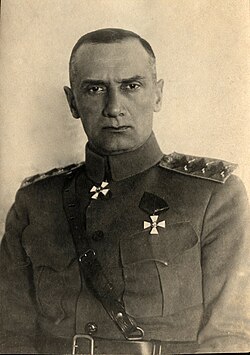
Supreme Leader Kolchak.
.png)
General Anton Denikin, Armed Forces of South Russia.

General Pyotr Wrangel, Caucasus Army.
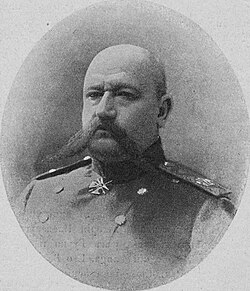
Nikolai Yudenich, Moustache Army and Northwestern Army.
White military failures[edit]

One of the most competent White commanders, Pyotr Wrangel, was responsible for securing the Kuban and the Caucasus for the Whites. Unfortunately for the Whites, Kolchak unwisely shackled Wrangel to the forces of Anton Denikin, who wanted to make a rapid push for Moscow.[66] While Wrangel wanted to focus on the more realistic target of Tsaritsyn (later called Stalingrad, then Volgograd), Denikin demanded that they focus on Moscow.
As Wrangel had predicted, the White offensive against Moscow rapidly lost steam as their front widened.[67] Even worse, the increasing distance between Denikin and his forces meant that he couldn't impose discipline on them, thus resulting in horrific instances of rape and looting and mass murder. By October 1919, the Reds were able to recover from their initial setbacks in the campaign and decisively defeat the White armies in the south.[68]

The campaign for Moscow also took resources away from the White attempt to seize the city of Tsaritsyn. The city was under a prolonged siege, but it survived in large part thanks to the Red military commander there, Joseph Stalin.[69] Stalin actually lost control of the city in a moment that temporarily emboldened the White cause, but he was able to retake it once bolstered by reinforcements.[70] The efforts around Tsaritsyn further stretched out the White war effort and resulted in a catastrophic defeat for them. Stalin's defense of the city made him a hero to the Bolsheviks, and Tsaritsyn would eventually be named Stalingrad in his honor.
Meanwhile in September 1919, the successful campaigns by the Baltic states to throw out the Reds opened the path for White General Nikolai Yudenich to make an attempt on Petrograd itself. His campaign was well-executed and threatened to take the city, but Trotsky refused to accept that loss and personally organized the city's defenses.[71] Yudenich lost the battle for control over the old capital, and Estonia's desire for peace with the Reds meant that Yudenich's armies had no place to go. His army eventually disbanded and thus ended any chance at the Whites taking Petrograd. This was one of the significant losses that convinced the Entente powers to start withdrawing their forces from northern Russia.[72]
Denikin's ill-considered plan to push against Moscow resulted in a catastrophic defeat that would doom the White movement as a whole. His forces had overextended themselves to the extent that White soldiers in the south lacked ammunition and had devolved into small patrolling bands, meaning that the Red counterattack totally destroyed their hold across the entire southern front.[73] It turned out that Denikin was kind of a dumbass. Kiev itself fell, and the shattered remnants of Denikin's army had to limp back to Siberia to seek protection from Kolchak's force. Nice. Meanwhile, Wrangel's forces had been left stranded in Crimea and were forced to evacuate by sea to Turkey.[74]
Red advance[edit]
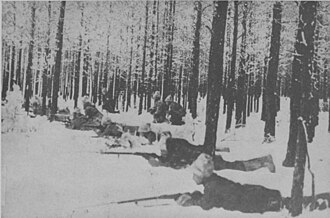
The White forces in the south had, while they existed, totally cut off the Red forces from Central Asia.[75] After the southern front's total destruction, that was no longer true, and the Basmachi Muslim states were suddenly exposed directly to communist aggression. Uh oh. While the Reds were in a better position to move in, they also started to lay the groundwork for continued rule by launching a campaign to promise the Central Asian Muslims that their religion and cultures would be respected.[76] That promise would only prove true for a short time.
In the Uralsk-Guryev Operation during September 1919, the Reds smashed White forces in the southern Urals and surrounded Kazakh forces, a major victory for the communists.[77] The retreat of the White forces from that campaign was called the Starving March because more than half of the soldiers died on their way further east.[78]
Siberia was now the only remaining White front, and the Red armies quickly went on the offensive against the exhausted, ill-equipped, and outnumbered White forces.
More anti-Bolshevik uprisings[edit]
.jpg)
While the war went well for the Reds, it came at a high cost. Internal crackdowns and chronic food shortages quickly resulted in peasant unrest. In 1920, the Tambov Rebellion exploded, a peasant revolt under the leadership of Socialist Revolutionary leader Alexander Antonov.[79] It began as an act of resistance to the Red Army's confiscation of grain crop and grew into a general war of defiance against the Bolshevik government. At its peak, the Tambov Rebellion counted over 50,000 men and managed to seize huge swathes of territory just south of Moscow.[80] The movement was too powerful and dangerous for the Reds to ignore, and they hastily assembled a force to move against them. The Red force was backed by airplanes, artillery, and armored cars. The Reds also took the extraordinary step of using chemical weapons against the peasant rebels, a horrifying crime that resulted in the movement's quick dissolution.[80] The Bolshevik reprisal resulted in at least 15,000 people being summarily executed and around 100,000 being sent off to camps.[79] Fuck.
That wasn't to be the end of things. The Russian Baltic Fleet's sailors, who had participated in the October Revolution by firing the shot that signaled the takeover of the Winter Palace in Petrograd,[81] also turned against the Bolshevik government. Soldiers and sailors on the island base of Kronstadt rose up in 1921 to protest Bolshevik economic policies, food shortages, political oppression, and violence.[82] This was a terrible shock to the Bolshevik government, as Lenin and Trotsky had both previously considered the Kronstadt sailors to be loyal heroes of the Bolshevik Revolution.[80] The Red Army attacked the Kronstadt base twice at the cost of thousands of lives on both sides. Although the Kronstadt movement failed, its goals were soon realized by the implementation of Lenin's New Economic Policy, which permitted some free market trade and small private business.[80]
White defeat[edit]
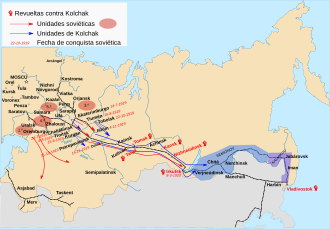
In late 1919, the Red assault against Siberia progressed as Kolchak had to flee further and further east along the Siberian railroad with train cars full of Tsarist treasure.[83] The winter in Siberia was unrelentingly harsh on both sides, but the undersupplied and disease-ridden White forces were affected by it to a much greater degree. The Whites adopted a scorched earth strategy by evacuating factories and blowing up bridges, and this was their only real hope as their armies were disorganized and heavily outnumbered.[84] Omsk itself, the capital of Kolchak's regime, fell to the Reds on 14 November 1919.[85]
Ejected from Omsk, the White forces had to retreat across Siberia in an attempt to escape the Red forces, an event called the "Great Siberian Ice March". The retreat was made even more difficult by the various peasant uprisings which targeted the Whites and resulted in many bloody battles that the Reds didn't even have to fight. Kolchak himself never made it to the end. In the city of Irkutsk (west of Lake Baikal), communist guerrillas captured and executed Kolchak and some of his top commanders on 7 February, 1920.[86] Politically beheaded and with no better ideas, the White Army continued withdrawing east towards Japanese lines.
The Japanese supported Grigory Semyonov as the new leader of the Whites, a movement which now only controlled the Russian Far East and had devolved into little more than a band of rapists and thieves.[87] The Japanese originally intended for Semyonov to be the leader of a puppet state in the Russian Far East, but the dictator's incompetence proved that this project was doomed to fail. The Japanese disgustedly withdrew from Russia in 1922, leaving the Whites to either go into exile or surrender to the Reds.
Establishment of the USSR[edit]
On 30 December 1922, the Russian SFSR, Ukrainian SSR, Byelorussian SSR, and Transcaucasian SFSR signed the Declaration of the Creation of the USSR, which united their various Soviet communist states into the Soviet Union.[88] Lenin had decided that reuniting the former Russian Empire under a single flag was the only way for the communist experiment to survive against a hostile world, and he claimed that the USSR was also to serve as the basis for the future unity of all Socialist countries in a World Socialist Soviet Republic.[89] In reality, the new USSR grew more authoritarian under single-party rule. Under Joseph Stalin, who took power after Lenin's death, the Soviet Union became a murderous and totalitarian dictatorship.
See also[edit]
- American Civil War
- Chinese Civil War
- Holodomor
- Spanish Civil War
- Korean War
- World War I
- World War II
External links[edit]
- Video: Russian Civil War mapped
- Video: The Russian Civil War in Early 1919.
References[edit]
- ↑ Leon Trotsky. Wikiquote.
- ↑ Russian Civil War (1917-22): 9,000,000. Necrometrics.
- ↑ The Russian Civil War. Military History Matters.
- ↑ Calder, Kenneth J. (1976). Britain and the Origins of the New Europe 1914-1918. International Studies. Cambridge: Cambridge University Press. ISBN 9780521208970. p. 166
- ↑ See the Wikipedia article on Kerensky–Krasnov uprising.
- ↑ See the Wikipedia article on Operation Faustschlag.
- ↑ Moscow becomes the capital of the Soviet state. Boris Yeltsin Presidential Library.
- ↑ 8.0 8.1 8.2 The Red Army. Alpha History.
- ↑ Cheka. Alpha History.
- ↑ See the Wikipedia article on Felix Dzerzhinsky.
- ↑ Felix Dzerzhinsky. Alpha History.
- ↑ TROTSKY’S ORDERS FOR DEFECTING RED ARMY OFFICERS (1918). Alpha History.
- ↑ Read, Christopher (1996). From Tsar to Soviets. Oxford: Oxford University Press. ISBN 9780195212419. p. 237
- ↑ Williams, Beryl, The Russian Revolution 1917–1921, Blackwell Publishing Ltd. (1987), ISBN 978-0-631-15083-1
- ↑ Treaty of Brest Litovsk. Michigan State University.
- ↑ Fischer, Ruth (1982) [1948]. Stalin and German Communism: A Study on the Origins of the State Party. New Brunswick NJ: Transition Books. p. 39. ISBN 0-87855-880-2.
- ↑ Russia and the Central Powers sign the Treaty of Brest-Litovsk. World War I Today.
- ↑ 18.0 18.1 18.2 The Treaty of Brest-Litovsk. History Today.
- ↑ Spencer C. Tucker (2013). The European Powers in the First World War: An Encyclopedia. p. 608.
- ↑ 20.0 20.1 See the Wikipedia article on Left SR uprising.
- ↑ Thompson, John M. (1996). A Vision Unfulfilled. Russia and the Soviet Union in the Twentieth Century. Lexington, MA. ISBN 9780669282917. p. 159.
- ↑ See the Wikipedia article on Revolt of the Czechoslovak Legion.
- ↑ 23.0 23.1 The White armies. Alpha History.
- ↑ Figes, Orlando (1997). A People's Tragedy: A History of the Russian Revolution. New York: Viking. ISBN 9780670859160. p. 656
- ↑ Bolshevism: “Foul baboonery…Strangle at Birth”. Hillsdale College.
- ↑ 26.0 26.1 Allied intervention in Russia, 1918-19. National Archives.
- ↑ The Forgotten Story of the American Troops Who Got Caught Up in the Russian Civil War. Smithsonian Magazine.
- ↑ 28.0 28.1 Britain’s Russian fiasco: the Allied intervention in the Russian civil war. History Extra.
- ↑ Left Socialist Revolutionaries. Encyclopedia.com
- ↑ 30.0 30.1 30.2 Maria Spiridonova. Alpha History.
- ↑ 31.0 31.1 Left SRs. Alpha History.
- ↑ Rabinowitch, Alexander (2007). The Bolsheviks in power. The first year of Soviet rule in Petrograd. Indiana University Press. p. 306. ISBN 9780253349439.
- ↑ See the Wikipedia article on Basmachi movement.
- ↑ See the Wikipedia article on Tashkent Soviet.
- ↑ Coates, W. P.; Coates, Zelda K. (1951). Soviets in Central Asia. New York: Philosophical Library. OCLC 1533874. p. 74
- ↑ Uzbekistan, By Thomas R McCray, Charles F Gritzner, pg. 30, 2004, ISBN 1438105517.
- ↑ See the Wikipedia article on Lithuanian–Soviet War.
- ↑ 38.0 38.1 Estonian War of Independence. Encyclopedia about Estonia.
- ↑ Raun, Toivo U.: Estonia and Estonians, page 108. Hoover Press, 2001, ISBN 9780817928520
- ↑ See the Wikipedia article on Latvian War of Independence.
- ↑ How the Revolution Armed. Marxists.org
- ↑ Struggle for Independence (1917–20). Encyclopedia of Ukraine.
- ↑ See the Wikipedia article on Polish–Ukrainian War.
- ↑ See the Wikipedia article on Makhnovia.
- ↑ Makhnovia: An Anarcho-Communist Experiment. Medium.
- ↑ See the Wikipedia article on Revolutionary Insurrectionary Army of Ukraine § First repudiation of the alliance.
- ↑ Torture Methods Used by the Cheka. Alpha History.
- ↑ Fanya Kaplan. Spartacus Educational.
- ↑ 49.0 49.1 How the 'Red Terror' Exposed the True Turmoil of Soviet Russia 100 Years Ago. TIME.
- ↑ The Red Terror. Alpha History.
- ↑ Lenin's Hanging Order. Alpha History.
- ↑ How the Red Terror set a macabre course for the Soviet Union. National Geographic.
- ↑ 53.0 53.1 53.2 The Execution of Tsar Nicholas II, 1918. Eyewitness to History.
- ↑ 54.0 54.1 Death of a dynasty: How the Romanovs met their end. National Geographic.
- ↑ On This Day in 1918 the Romanov Family Was Killed. Moscow Times.
- ↑ Vladimir Lenin. Wikiquote.
- ↑ CRIMES AND MASS VIOLENCE OF THE RUSSIAN CIVIL WARS (1918-1921).
- ↑ See the Wikipedia article on White Terror (Russia) § Eastern Russia.
- ↑ Mawdsley, Evan (2007). The Russian Civil War. New York: Pegasus Books. ISBN 9781681770093. p. 29.
- ↑ See the Wikipedia article on Ice March.
- ↑ See the Wikipedia article on Kuban Offensive.
- ↑ See the Wikipedia article on Provisional All-Russian Government.
- ↑ Alexander Kolchak. Alpha History.
- ↑ See the Wikipedia article on Northwestern Army (Russia).
- ↑ See the Wikipedia article on Supreme Ruler of Russia.
- ↑ See the Wikipedia article on Pyotr Wrangel.
- ↑ Denikin's Moscow Campaign. Library of Congress.
- ↑ See the Wikipedia article on Advance on Moscow (1919).
- ↑ The Battles of Old Russia. Medium.
- ↑ Kinvig, Clifford. "Churchill's Crusade: The British Invasion of Russia, 1918-1920". Hambledon Continuum: 2006, p. 225; ISBN 9781847250216.
- ↑ See the Wikipedia article on Battle of Petrograd.
- ↑ Allworth, Edward (1967). Central Asia: A Century of Russian Rule. New York: Columbia University Press. OCLC 396652. p. 231
- ↑ Kenez, Peter (1977). Civil War in South Russia, 1919–1920: The Defeat of the Whites. Berkeley: University of California Press. ISBN 9780520033467.
- ↑ See the Wikipedia article on Evacuation of the Crimea.
- ↑ Coates, W. P.; Coates, Zelda K. (1951). Soviets in Central Asia. New York: Philosophical Library. OCLC 1533874. p. 76.
- ↑ Allworth, Edward (1967). Central Asia: A Century of Russian Rule. New York: Columbia University Press. OCLC 396652.p. 232–233.
- ↑ Uralsk-Guryev Operation. Pygymy Wars.
- ↑ Smele, Jonathan D. (2015). Historical Dictionary of the Russian Civil Wars, 1916–1926. Rowman & Littlefield Publishers. pp. 1082–1083. ISBN 978-1-4422-5281-3.
- ↑ 79.0 79.1 See the Wikipedia article on Tambov Rebellion.
- ↑ 80.0 80.1 80.2 80.3 4 insurrections that shook Soviet Russia. Russia Beyond.
- ↑ Cruiser Aurora. Saint Petersburg.
- ↑ Kronstadt rebellion. Alpha History.
- ↑ The Liquidation of Kolchak and His Followers. Library of Congress.
- ↑ The Commanding General of the American Expeditionary Forces in Siberia (Graves) to The Adjutant General (Harris). US State Department.
- ↑ See the Wikipedia article on Great Siberian Ice March.
- ↑ W. Bruce Lincoln (1999) Red Victory: A History of the Russian Civil War, 1918–1921, DaCapo Press, ISBN 0306809095
- ↑ See the Wikipedia article on Grigory Mikhaylovich Semyonov.
- ↑ See the Wikipedia article on Declaration of the Creation of the USSR.
- ↑ How was the USSR formed? Russia Beyond.
Categories: [Asian history] [Authoritarianism] [Communism] [Cold War] [Crimes against humanity] [European history] [History] [History of communism] [Revolution] [Russia] [Russian history] [War crimes] [World War I]
↧ Download as ZWI file | Last modified: 11/07/2025 00:55:59 | 63 views
☰ Source: https://rationalwiki.org/wiki/Russian_Civil_War | License: CC BY-SA 3.0
 KSF
KSF